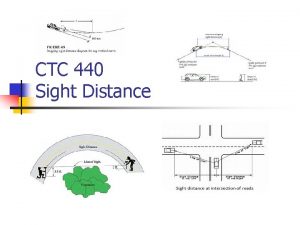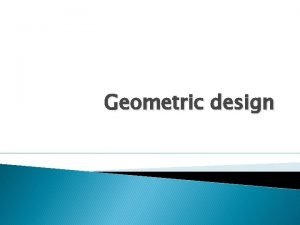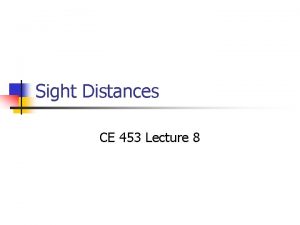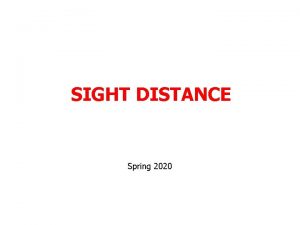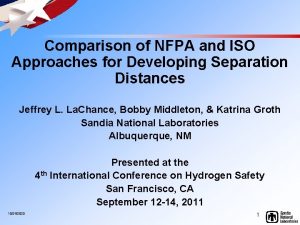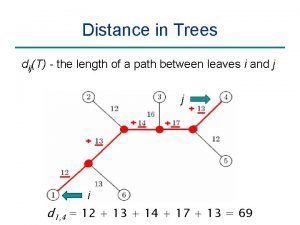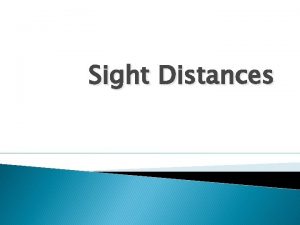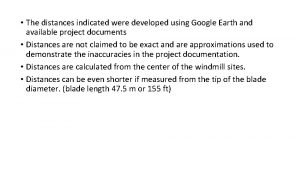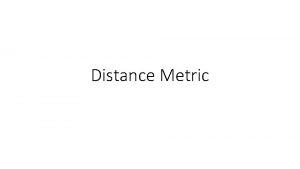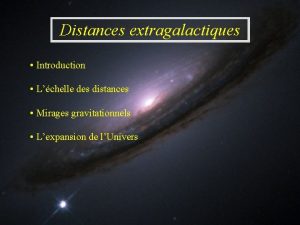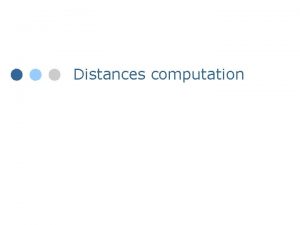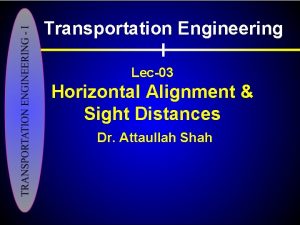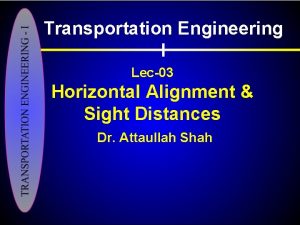Lecture Sight distances Decision sight distance As indicated











- Slides: 11

Lecture Sight distances

Decision sight distance • As indicated in the discussion of perception reaction time and stopping sight distance, there are many situations where stopping sight distance is not sufficient for safe and smooth operations. Complex conditions, problems of expectancy, high volumes and high speed require more time for the perceptionreaction process. • These conditions are present on arterial streets and highways, particularly in urban areas. The AASHTO Policy on Geometric Design has provided for such situations through the decision sight distance

Difference between SSD and DSD • Stopping sight distance is used when the vehicle is traveling at design speed on a poor wet pavement when one clearly discernable object or obstacle is presented in the roadway. • Decision sight distance applies when conditions are complex, driver expectancies are different from the situation, or visibility to traffic control or design features is impaire

Cont. . , • Most situations presented on arterials for access management require stopping sight distance at a minimum; however, decision sight distance should be provided for safety and smoother operations.

DSD by AASHTO • The decision sight distance as defined by the AASHTO Green Book is “the distance required for a driver to detect an unexpected or otherwise difficult-to-perceive information source or hazard in a roadway environment that may be visually cluttered, recognize the hazard or its threat potential, select an appropriate speed and path, and initiate and complete the required maneuver safely and efficiently. ” • According to AASHTO, the decision sight distance requires about 6 to 10 s to detect and understand the situation and 4 to 4. 5 s to perform the appropriate maneuver. The sight distance is typically measured from a 1070 mm (3. 5 in. ) object; however, this should depend on the condition that requires the decision sight distance.

Design speed • Design speed is the maximum safe speed that can be maintained over a specified section of a highway when conditions are so favorable that the design features of the highway govern. ” (AASHTO, 1990). The selection of a suitable design speed will depend on the terrain and functional class of the highway. Typical design speeds for freeways range from 50 mph to 70 mph depending on the terrain type (level, rolling or mountainous).

Passing sight distance and crest vertical curve • A n important issue on two way highway(one lane in each direction) • Passing sight distance is a factor only in crest vertical curve design • For sag vertical curves , sight distance is unobstructed looking up or down the grade

Equations • PSD < L • Lm= A X PSD² /2800 • PSD > L • Lm=2 X PSD - 2800/A • Lm=minimum length of curve • PSD= passing sight distance in feet • A= absolute value of difference in grades

Passing sight distance

Passing sight distance

Cont. , • D 1=The initial maneuver distance (driver perception /reaction time + time it takes to bring the vehicle from its trailing speed to the point of encroachment on the left lane) • D 2=distance that the passing vehicle traverse while occupying the left lane • D 3= the clearance length between the passing and the opposing vehicle at the end of passing maneuver • D 4= distance traverse by the opposing veicle during two-third of the time the passing vehicle occupies the left lane.
 Objectives of decision making
Objectives of decision making Slidetodoc.com
Slidetodoc.com Stopping sight distance formula aashto
Stopping sight distance formula aashto Vertical
Vertical Stopping distance formula
Stopping distance formula Stopping sight distance formula
Stopping sight distance formula 01:640:244 lecture notes - lecture 15: plat, idah, farad
01:640:244 lecture notes - lecture 15: plat, idah, farad Bayesian decision theory lecture notes
Bayesian decision theory lecture notes Decision theory lecture notes
Decision theory lecture notes The furthest distance i've travelled
The furthest distance i've travelled Iso 11620
Iso 11620 Tree distances i
Tree distances i


